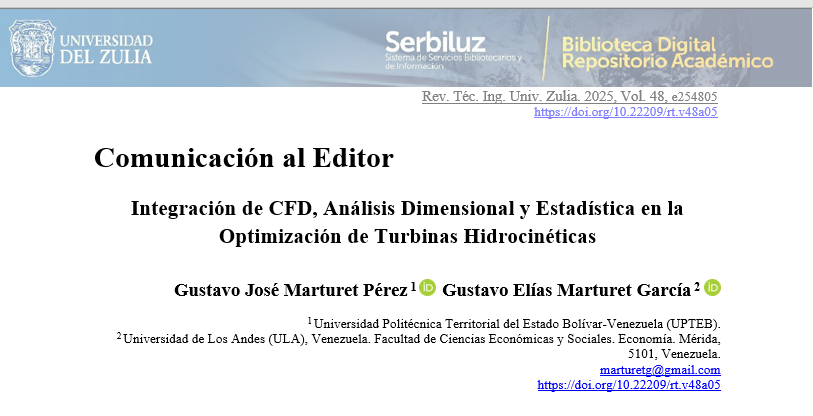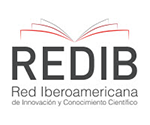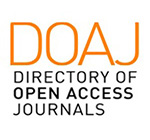Integration of CFD, Dimensional Analysis and Statistics in the Optimization of Hydrokinetic Turbines
Abstract
This communication explores the optimization of hydrokinetic turbines, key devices for sustainable
energy generation in isolated areas, as evidenced by projects in Scotland and France. To overcome high
experimental costs, the research focuses on Computational Fluid Dynamics (CFD) and numerical analysis
methodologies. The main objective is to analyze the integration of CFD, the Buckingham π Theorem, and
Statistics in the optimization of these turbines. The article reviews existing literature, establishing a theoretical
framework for future research. It highlights CFD's role in flow analysis and critical parameter determination,
and how the Buckingham π Theorem simplifies fluid equations and facilitates scaling. Statistics, in turn, are
fundamental for design, optimization, performance evaluation, and the development of predictive models.
Finally, the research emphasizes the growing integration of Artificial Intelligence (AI), including machine
learning and deep learning, as a novel approach to enhance the design, optimization, and control of
hydrokinetic turbines, opening new avenues for the advancement of this energy technology.
Downloads
References
Amran Abolholl, H. A., Teschner, T. R., & Moulitsas, I. (2024). A hybrid computer vision and machine learning approach for robust vortex core detection in fluid mechanics applications. Journal of Computing and Information Science in Engineering, 24(6).
Esfahanian, V., Izadi, M. J., Bashi, H., Ansari, M., Tavakoli, A., & Kordi, M. (2024). Aerodynamic shape optimization of gas turbines: a deep learning surrogate model approach. Structural and Multidisciplinary Optimization, 67(1), 2.
Etemadeasl, V., Esmaelnajad, R., Gharlai, K., & Riasi, A. (2024). Application of Entropy Production Theory for Evaluating the Performance of a Gorlov Hydrokinetic Turbine. Iranian Journal of Science and Technology, Transactions of Mechanical Engineering, 1-20.
Jayaram, V., & Bavanish, B. (2021). A brief review on the Gorlov helical turbine and its possible impact on power generation in India. Materials Today: Proceedings, 37, 3343-3351.
Jia, W., & Xu, H. (2024). Optimal parallelization strategies for active flow control in deep reinforcement learning-based computational fluid dynamics. Physics of Fluids, 36(4).
Kim, I., Jeon, Y., Chae, J., & You, D. (2024). Deep reinforcement learning for fluid mechanics: Control, optimization, and automation. Fluids, 9(9), 216.
Li, G., Wu, G., Tan, L., & Fan, H. (2023). A Review: Design and Optimization Approaches of the Darrieus Water Turbine. Sustainability, 15(14), 11308.
Marturet, G. (2019). Modelación fluidodinámica de turbinas Gorlov para la mejora de su rendimiento. Tesis doctoral. Puerto Ordaz: UNEXPO.
https://www.researchgate.net/publication/345356850_Modelacion_fluidodinamica_de_turbinas_Gorlov_para_la_mejora_de_su_rendimiento
Marturet Pérez, G. J., Marturet García, G. E., & Torres Monzón, C. F. (2022). Análisis CFD en Régimen Transitorio para la Determinación de Cavitación en Turbinas Helicoidales Gorlov. Revista Técnica de la Facultad de Ingeniería de la Universidad del Zulia, 45(2).
Marturet Pérez, G. J., Marturet García, G. E., Guerra Silva, R. A., Josefina Torres, M., & Torres Monzón, C. F. (2023). Análisis CFD sobre la Influencia del Ángulo de Ataque en el Coeficiente de Potencia de Turbinas Helicoidales Gorlov. Revista Técnica de la Facultad de Ingeniería de la Universidad del Zulia, 46.
Olausson, R. (2024). Wall modeled computational fluid dynamics using machine learning. Using CFD coupled machine learning to create wall models for increased LES knowledge for future industrial use. https://odr.chalmers.se/items/89db12c8-7349-4ab2-b8fe-d633ae3d12bc
Saini, G., & Saini, R. P. (2019). A review on technology, configurations, and performance of cross‐flow hydrokinetic turbines. International Journal of Energy Research, 43(13), 6639-6679.
Surulere, S. A., Shatalov, M. Y., & Olayiwola, F. E. (2024). Extensive Study of Modern Approaches Used in Identifying the Buckingham Potential. International Journal of Applied and Computational Mathematics, 10(1), 22.

Copyright (c) 2025 Gustavo José Marturet Pérez, Gustavo Elías Marturet García

This work is licensed under a Creative Commons Attribution-NonCommercial-ShareAlike 4.0 International License.
Copyright
La Revista Técnica de la Facultad de Ingeniería declara que los derechos de autor de los trabajos originales publicados, corresponden y son propiedad intelectual de sus autores. Los autores preservan sus derechos de autoría y publicación sin restricciones, según la licencia pública internacional no comercial ShareAlike 4.0










_2.04__.27_p__._m__.__.png)


















